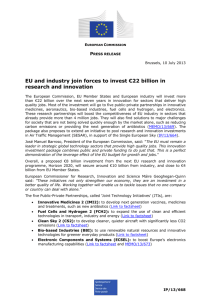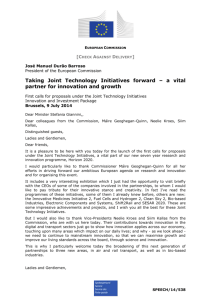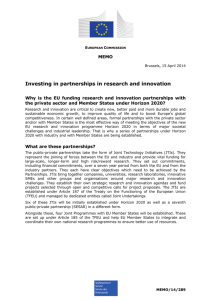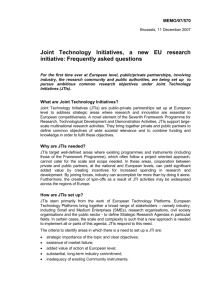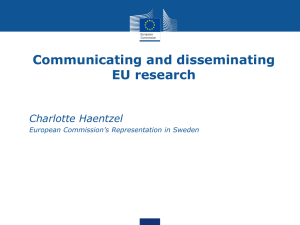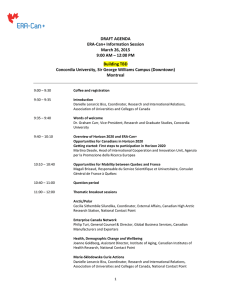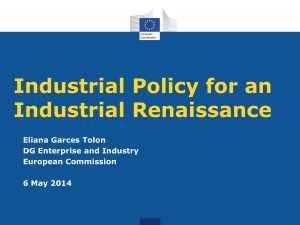DOC
advertisement
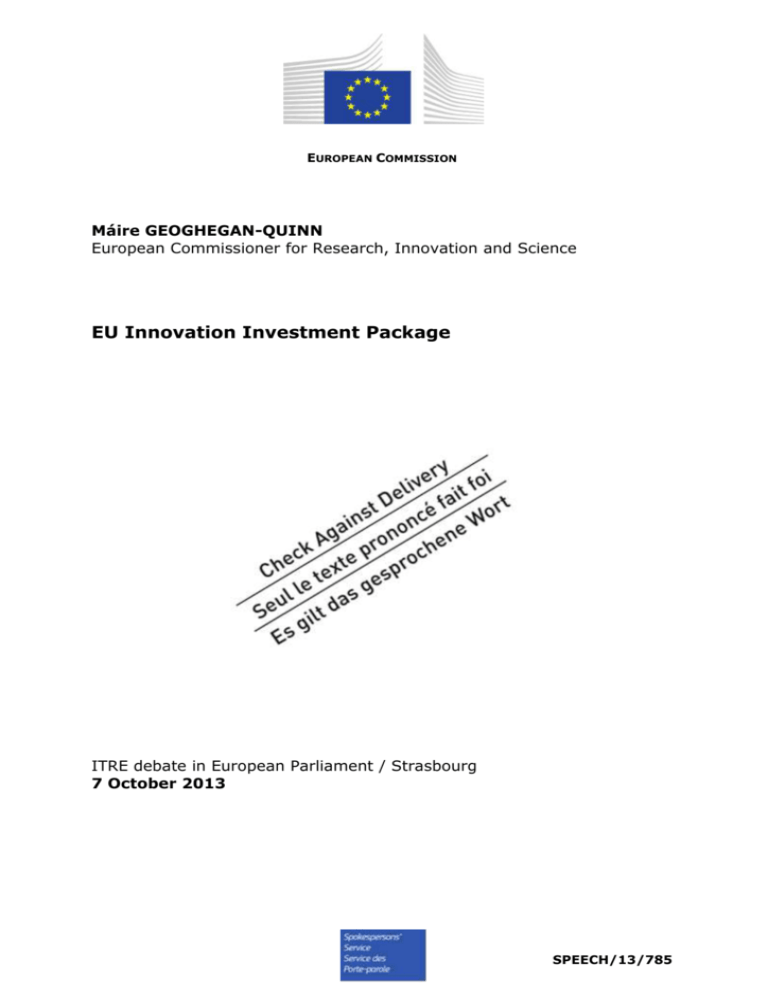
EUROPEAN COMMISSION Máire GEOGHEGAN-QUINN European Commissioner for Research, Innovation and Science EU Innovation Investment Package ITRE debate in European Parliament / Strasbourg 7 October 2013 SPEECH/13/785 Honourable members, I would like to thank the ITRE committee for organising this debate tonight on the Innovation Investment Package. After long, enriching and sometimes tough negotiations you adopted the Horizon 2020 package on 26 September, and the plenary vote will follow later this month. Thank you for your invaluable work that has produced an excellent result. It means that Horizon 2020 will start on time in January, something that researchers and stakeholders all across Europe are waiting for. I am delighted to present the Commission’s proposal for five public-private partnerships and four public-public partnerships, which was adopted in July as the “Innovation Investment Package”. The European Council has asked the Commission to maximise the impact of the new EU budget on growth, and this is exactly what we have proposed in this Package. It has a proposed budget of some 22 billion Euro, of which around 8 billion from Horizon 2020 would leverage 10 billion from industry and 4 billion from Member States. The public-private partnerships The public-private partnerships will be in the form of Joint Technology Initiatives (JTIs) in key strategic sectors for the future of European industry: pharmaceuticals, new energy technologies, aeronautics, the bio-based economy, and electronics. The public-public partnerships are joint programmes with the Member States in the areas of Clinical Trials, SMEs, Metrology and Active and Assisted Living. Building on the experience and evaluations of the current JTIs under FP7, the Commission has proposed significant changes in the new generation of JTIs under Horizon 2020. This is not business as usual. First, each JTI has clear and measurable objectives set out in the legal base. These are backed up with key performance indicators, closely related to the challenges addressed. Second, there is a higher level of commitment from industry partners. This allows us to leverage more investment from the EU budget and enables the JTIs to bridge the gap between research and deployment. Third, we have introduced improved governance of the JTIs to ensure that they are open to new partners and new participants across Europe. In all cases, the majority of EU funding will be allocated through fully open, competitive calls. A fourth major change is simplification. All of the JTIs will follow the standard Horizon 2020 rules, with derogations kept to an absolute minimum. In addition we have proposed a specific status for the JTIs under the new Financial Regulations that will make them more efficient. I have high hopes for this new generation of JTIs. On the day the Commission proposal was adopted, President Barroso, Vice President Kroes and I met with Chief Executives of leading companies in each of the JTIs. It was clear from this meeting that industry is absolutely committed to the JTIs, that they are ready to invest, and that JTIs are vital to their future competitiveness. I was particularly struck by the willingness of competitors to join forces on complex, large scale challenges that are critical for Europe. The budget is commensurate with this new level of ambition and the greater commitment from the industry partners. It amounts to 11% of the overall Horizon 2020 budget, but will leverage much more from industry. 2 Horizon 2020's contribution will be used primarily for collaborative projects that are open to participants in exactly the same way as the rest of Horizon 2020. This is the best way to get maximum impact from the EU budget for growth and jobs, and I very much hope that the Parliament will share the same level of ambition as the Commission and the industry partners. Thus, the proposed JTIs respond directly to the call from the European Council to prioritise the impact of the Multiannual Financial Framework on growth and jobs. We have chosen the sectors and areas where we need to join forces with the private sector and with Member States in order to achieve results that one country or company is unlikely to achieve alone. They will also attract private investment to Europe and allow us to compete against other regions that are investing heavily in these areas. Let me briefly introduce the four JTIs under my responsibility and also the ECSEL JTI, which is under the responsibility of Commissioner Kroes. The Innovative Medicines Initiative 2 (IMI2) JTI aims to get urgently needed next generation vaccines, medicines and treatments to patients faster. Specific objectives include a 30% better success rate in clinical trials of priority medicines identified by the WHO; clinical proof of concept in immunological, respiratory, neurological and neurodegenerative diseases; and new antibiotics or new therapies for Alzheimer’s disease. Fuel Cell and Hydrogen (FCH) technologies can make a major contribution to a lowcarbon society, but are still too expensive to compete with incumbent technology. The first-generation initiative on Fuel Cells and Hydrogen generated strong technical progress. The proposed successor will help bring down costs and improve performance so that the technologies can be successfully commercialised in many applications. Another strategic sector is Aeronautics where strong cooperation between different countries has given Europe a leading edge. However, European aviation faces immense environmental and competitiveness challenges. The Clean Sky JTI has been very successful, with more than 500 organisations working together to make aviation cleaner. Now we are entering into the next, more challenging phase of this partnership. Clean Sky 2 will develop and demonstrate new break-through technologies for the civil aircraft market to cut aircraft emissions and noise, and secure the industry's future competitiveness. The JTI on Bio-based Industries is entirely new. It is a flagship of the European Bioeconomy Strategy and updated Industrial Policy that aims to accelerate the transition towards a more resource efficient post-petroleum economy; boost regional growth and jobs, especially in rural areas; and increase the competitiveness of the European industries. On this, let me thank you for your recent report on the bio-economy. This new JTI demonstrates the Commission's conviction that the emerging sector of biobased industries is a game-changer in the pursuit of smart, sustainable and inclusive growth in Europe. The JTI will generate the necessary momentum to unite world-beating European companies and researchers around new value chains that will make bio-based products a sustainable alternative to fossil fuels. The new ECSEL JTI (Electronic Components and Systems) will combine EU, national and industrial resources to cover the full electronics value chain and bridge the gap between research and deployment, through large scale projects and pilot lines for production. 3 We are building on the lessons of the ARTEMIS and ENIAC JTIs, with a single partnership to cover hardware, embedded software and smart systems. That will make the programme easier, faster and more engaging and provide greater impact. The single initiative will strengthen the most important links in the value chain: namely design, manufacturing and integration in final products. Vice-President Kroes is very encouraged by the positive responses to the strategy and public-private partnership. The public-public partnerships The Innovation Investment Package also includes four proposals to establish publicpublic partnerships with Member States under Article 185 of the Treaty on the joint implementation of national research programmes. Under the overall leadership of participating Member States and Associated Countries, these partnerships help overcome unnecessary overlap and fragmentation of public research and innovation efforts, leading to a true integration between Member States in all aspects of a joint research programme – at financial, scientific and managerial level. This is about getting more value and impact out of public research spending across Europe. The proposed new public-public partnerships build on initiatives launched under FP6 and FP7 that have had considerable success. In line with Horizon 2020, the new proposals are challenge-based and contribute to European competitiveness. The overall EU budget for these proposals amounts to 3.5 billion euro, which will be combined with funding from the Member States and Associated Countries. The first EDCTP (European and Developing Countries Clinical Trials Partnership) (20032012) has so far supported 88 clinical trials in sub-Saharan Africa involving collaboration between experts from Europe and sub-Saharan Africa. New and better treatments for HIV/AIDS and malaria have been developed, especially for new-borns, children, pregnant women and nursing mothers. Following this successful collaboration, EDCTP 2 will have a broader scope, supporting the full clinical development of medical products against any poverty-related disease. The Eurostars initiative has addressed the needs of research performing SMEs and brought together resources from national programmes. Eurostars 2 will pursue the same objectives with a reinforced partnership, involving even more SMEs, particularly those new to transnational research. The new initiative will also usher in greater harmonisation and synchronisation of national programmes. Eurostars 2 will complement Horizon 2020's other measures for innovative SMEs, notably the new SME instrument and the financial instruments. The proposed European Programme for Metrology Research and Innovation (EMPIR) aims to integrate 50% of the research of National Metrology Institutes in Europe into a single initiative, with 28 Participating countries. EMPIR will strengthen European leadership in providing measurement solutions to support industrial competitiveness and help solve societal challenges such as in health, environment and energy. Finally, I would like to say something on the Active and Assisted Living Programme, which is under the responsibility of Commissioner Kroes. It is a good example of how digital innovations can help older people stay independent and active for longer, while stimulating growth, jobs and European leadership. 4 Member States, the EU and companies, especially small companies, are joining forces on new ideas for ageing well. This is the fast lane to a thriving market; with new products meeting European needs. No region should keep good ideas to itself! They're for sharing and scaling up. That success is why we are following up the current AAL Joint Programme with something even better than the original, with a wider scope and quicker faster financial support. It’s a great way to spread local innovations and ensure that people get the best possible care. Dear Chair, Dear Members, I know that you will now start your formal discussions in ITRE on these dossiers. I am confident that our joint efforts will result in a timely adoption of all legislative acts so that the new partnerships can be up and running in early 2014. Thank you. 5
